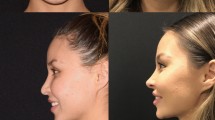Abstract
Background
Triamcinolone acetonide injections (TAIs) have been suggested to decrease complications following rhinoplasty. This systematic review aimed to assess the efficacy and safety of TAIs following rhinoplasty.
Methods
We performed a systematic literature search on Medline, Embase, Google Scholar, and Cochrane Central Register of Controlled Trials from inception to May 2023, without any timeframe limitations. The following terms were used: (Triamcinolone OR steroid injections OR triamcinolone acetonide) AND (Skin thickness OR supratip edema OR supratip deformity OR Pollybeak deformity) AND (rhinoplasty OR external rhinoplasty). We included randomized controlled trials and observational studies (prospective, retrospective, and case series).
Results
In total, six of the 1604 articles met our inclusion criteria. A total of 1524 patients were included in this study. Our results included patient demographics, type of rhinoplasty, post-injection follow-up period, site of injection, type of syringe used, timing of the first dose, volume and concentration used, time interval between doses, response to the injection, and complications of injection.
Conclusion
To our knowledge, this is the first systematic review to address this issue. Our results demonstrate the ease and safety of TAIs as a first-line treatment, with positive outcomes and limited complications. TAIs can be used early postoperatively to minimize the need for revision surgery. Despite the limited number of studies on TAIs, this study provides the best available evidence that can help surgeons decide when to use the injection, the intervals between doses, and the duration of use. Further randomized controlled trials are required to confirm our findings.
Level of Evidence II
This journal requires that authors assign a level of evidence to each article. For a full description of these Evidence-Based Medicine ratings, please refer to the Table of Contents or the online Instructions to Authors www.springer.com/00266.


Similar content being viewed by others
Availability of Data and Materials
All data generated or analyzed during this study are included in this published article and its supplementary information files.
References
Hyun SM, Jung DH (2019) Correction of the soft tissue problem using triamcinolone injection after rhinoplasty. J Cosmetic Med 3(2):71–74. https://doi.org/10.25056/JCM.2019.3.2.71
Saedi B, Amali A, Arabpor M (2017) Comparison of two concentrations of triamcinolone injection in the prevention of supratip edema after external rhinoplasty: a randomized trial. Am J Rhinol Allergy 31(6):412–415. https://doi.org/10.2500/ajra.2017.31.4479
Guyuron B, DeLuca L, Lash R (2000) Supratip deformity: a closer look. Plast Reconstr Surg 105(3):1140–1151. https://doi.org/10.1097/00006534-200003000-00049
Rettinger G (2007) Risks and complications in rhinoplasty. GMS Curr Top Otorhinolaryngol Head Neck Surg 6:08
Hussein W, Foda H (2016) Pollybeak deformity in middle eastern rhinoplasty: prevention and treatment. Facial Plast Surg 32(04):398–401. https://doi.org/10.1055/s-0036-1585571
Hanasono MM, Kridel RWH, Pastorek NJ, Glasgold MJ, Koch RJ (2002) Correction of the soft tissue pollybeak using triamcinolone injection. Arch Facial Plast Surg 4(1):26–30. https://doi.org/10.1001/archfaci.4.1.26
Rees TD (1971) An aid to the treatment of supratip swelling after rhinoplasty. Laryngoscope 81(2):308–311. https://doi.org/10.1288/00005537-197102000-00011
Mahe E, Camblin J, Pelligrini VM (1975) Treatment of postoperative Corbin’s beak using repeated local triamcinolone acetonide injections. Ann Chir Plast 20(1):79–86
Lubczyńska A, Kociecki J (2007) Inhtravitreal triamcinolone acetonide injections in the treatment of cystoid macular edema due to the central or branch retinal vein occlusion. Klin Oczna 109(4–6):169–172
Pulikkottil BJ, Dauwe P, Daniali L, Rohrich RJ (2013) Corticosteroid use in cosmetic plastic surgery. Plast Reconstr Surg 132(3):352e–360e. https://doi.org/10.1097/PRS.0b013e31829acc60
Schardt C, Adams MB, Owens T, Keitz S, Fontelo P (2007) Utilization of the PICO framework to improve searching PubMed for clinical questions. BMC Med Inform Decis Mak 7(1):16. https://doi.org/10.1186/1472-6947-7-16
Cumpston M, Li T, Page MJ et al (2019) Updated guidance for trusted systematic reviews: a new edition of the Cochrane Handbook for Systematic Reviews of Interventions. Cochrane Database Syst Rev. https://doi.org/10.1002/14651858.ED000142
Ouzzani M, Hammady H, Fedorowicz Z, Elmagarmid A (2016) Rayyan—a web and mobile app for systematic reviews. Syst Rev 5(1):210. https://doi.org/10.1186/s13643-016-0384-4
Irvine L, Nassif P (2018) Use of 5-fluorouracil for management of the thick-skinned nose. Facial Plast Surg 34(01):009–013. https://doi.org/10.1055/s-0037-1617420
Aydın C, Yücel ÖT, Akçalar S et al (2021) Role of steroid injection for skin thickness and edema in rhinoplasty patients. Laryngoscope Investig Otolaryngol 6(4):628–633. https://doi.org/10.1002/lio2.616
Baker DC (1979) Treatment of obstructing inferior turbinates with intranasal corticosteroids. Ann Plast Surg 3(3):253–259
McCleve D, Goldstein J, Silver S (1978) Corticosteroid injections of the nasal turbinates: past experience and precautions. Otolaryngol Head Neck Surg 86(6):851
Funding
The authors do not have any conflict of funding to declare.
Author information
Authors and Affiliations
Contributions
BA contributed to study protocol, literature screening, and full-text assessment, created the tables, reviewed and edited the initial draft, and supervised and led the study. MK conceptualized the idea, created the tables, wrote the abstract and the cover letter, reviewed and edited the initial draft, and supervised and led the study. LT was involved in the literature screening by title and abstract, full-text assessment, and data extraction. FAA was responsible for full-text assessment, data extraction, and assessment of the risk of bias. WA submitted the proposal for PRESPERO, and wrote the methods and discussion. RAA wrote the introduction, discussion, and conclusion writing, and rearranged the references. HM, FMO, and AA supervised the study and proofread the final draft.
Corresponding author
Ethics declarations
Conflict of interest
The authors do not have any conflict of interest to disclose.
Ethical Approval
Not applicable due to the nature of the study.
Informed Consent
Not applicable due to the nature of the study.
Additional information
Publisher's Note
Springer Nature remains neutral with regard to jurisdictional claims in published maps and institutional affiliations.
Rights and permissions
Springer Nature or its licensor (e.g. a society or other partner) holds exclusive rights to this article under a publishing agreement with the author(s) or other rightsholder(s); author self-archiving of the accepted manuscript version of this article is solely governed by the terms of such publishing agreement and applicable law.
About this article
Cite this article
Khan, M., AlRajhi, B., Turkistani, L. et al. Efficacy and Safety of Triamcinolone Acetonide Injections Following Rhinoplasty: A Systematic Review of Recommended Doses, Complications, and Outcomes. Aesth Plast Surg (2024). https://doi.org/10.1007/s00266-024-03967-6
Received:
Accepted:
Published:
DOI: https://doi.org/10.1007/s00266-024-03967-6




